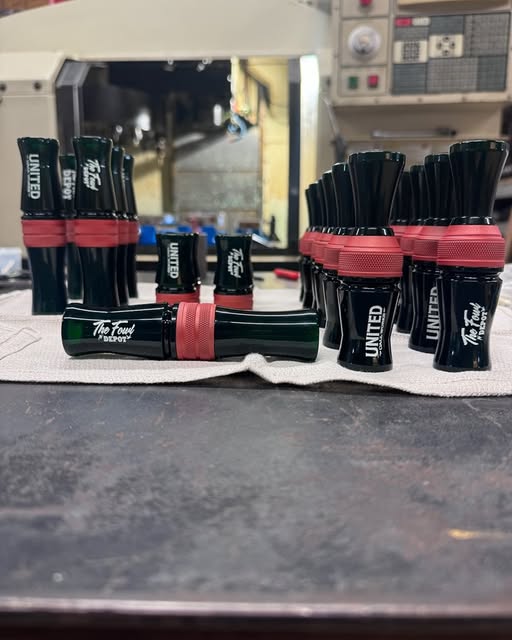
Mastering Duck and Goose Calls: Tips for Using Single Reed and Double Reed Calls
Share
Mastering Duck and Goose Calls: Tips for Using Single Reed and Double Reed Calls
When you're out in the field hunting waterfowl, having the right calls can make all the difference. Whether you're a beginner or a seasoned hunter, understanding how to properly use your duck and goose calls is key to attracting the right birds to your spread. At The Fowl Depot, we offer top-quality gear to help you perfect your calling technique, such as our Lanyard and UCW Game Call Kit and UCW Waterfowl Calls. These calls are designed for hunters who want to elevate their calling game and improve their chances of a successful hunt.
Understanding Single Reed and Double Reed Calls
Before we dive into some tips and techniques, it's important to understand the differences between single reed and double reed calls.
-
Single Reed Calls: These are often preferred by experienced hunters because they allow for more versatility in tone and pitch. Single reed calls can produce a wider range of sounds, making them excellent for mimicking different types of waterfowl calls. However, they can be more challenging to master, as they require precise control of airflow and pressure.
-
Double Reed Calls: Double reed calls are great for beginners because they are easier to blow and produce a more forgiving sound. They are known for their deeper, softer tones, making them ideal for calling ducks in close range. They are also more forgiving of mistakes, so you don’t need as much precision to get a good sound.
Tips for Calling Ducks with Single and Double Reed Calls
Whether you're using a single or double reed call, there are a few basic tips that will help you get the most out of your calls.
1. Proper Hand Position
Your hand placement can greatly affect the sound of your call. For a single reed call, use your hand to help modulate the tone by cupping your hand around the call. The closer you keep your hand to the barrel of the call, the louder and more intense the sound. For double reed calls, cupping your hand around the call can also help project sound, but it's typically less necessary to manipulate the tone as much as with single reed calls.
2. Control Your Airflow
The key to creating realistic calls lies in your airflow. For single reed calls, focus on controlling the pressure of your air to change the pitch. A softer breath can mimic a duck calling at a distance, while a harder breath creates a more urgent, closer call. Double reed calls are more forgiving with airflow, but controlling your air helps in producing a crisp sound.
3. Practice the Basic Calls
For both single reed and double reed calls, mastering the basic sounds is crucial. The quack is the most essential call for both species. For ducks, focus on learning how to make a clean "quack" sound, which is the foundation of most calls. For geese, the "honk" is the most important sound to master. Once you've got these basic calls down, you can start adding variations and cadence.
4. Use the Right Call for the Situation
Different calls are suited for different scenarios. If you're trying to get the attention of distant birds, a long, loud call might be necessary, especially with a single reed call. For closer birds, you'll want to soften the calls and focus on subtle nuances to mimic the natural sounds of ducks and geese in the area. Double reed calls are often better for close-range work, while single reed calls can be used to reach out over greater distances.
5. Don't Overdo It
A common mistake is overcalling. Sometimes less is more, especially when ducks or geese are already in the area. Calling too much can spook birds, so always pay attention to their behavior. If they seem interested, ease off and allow them to make their move.
Goose Calling Tips
Goose calls are often different from duck calls, requiring a different approach. With the UCW Waterfowl Calls, you'll get a goose call that allows you to replicate the deep, throaty tones geese make. Here are some tips:
-
Focus on the "Honk"
The honk is the staple call for geese. Practice making a deep, resonating honk by adjusting your tongue position and airflow. It should feel like a deep, guttural noise coming from your chest. -
Cluck and Murmur for Subtle Sounds
For more subtle geese calls, such as clucks or murmurs, adjust your airflow and tongue placement. These sounds are typically used when geese are in the area, and you're trying to keep them engaged and calm. -
Learn the Right Cadence
Geese have a particular cadence to their calls, and mimicking this will increase your chances of drawing them in. Focus on slow, deliberate honks with pauses in between to create a natural flow.
Why Choose UCW Waterfowl Calls?
At The Fowl Depot, we understand the importance of having reliable, high-quality calls in the field. That's why we offer products like our Lanyard and UCW Game Call Kit and UCW Waterfowl Calls, which are perfect for both beginners and experienced hunters alike. These calls provide superior sound quality and durability, giving you the best chance of attracting the waterfowl you're targeting.
Conclusion
Whether you're using a single reed or double reed call, the key to successful calling lies in practice and control. Remember to start with the basics, learn the sounds of the birds you're targeting, and practice your technique in different conditions. With the right tools, like our UCW Waterfowl Calls, you'll be well on your way to becoming a master at calling ducks and geese. Happy hunting, and be sure to check out our products to elevate your calling game!
